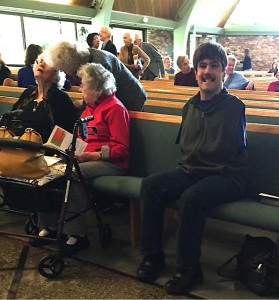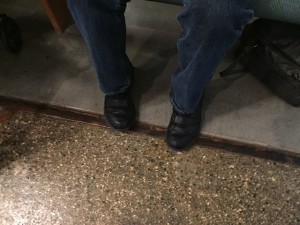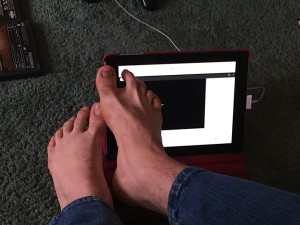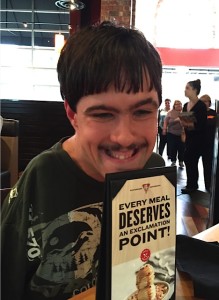In my previous blog about Kolya I focused on his running and climbing adventures (and there are many more running and climbing adventures to share if you’d like me to). There were many other behaviors we dealt with that I’d almost forgotten had ever happened.
Behavior modification, structured environment in the home, and therapy, were recommendations made by doctors and school personnel. It was close to impossible for me to provide most any of these because of the ongoing care my other sons required. I couldn’t even picture therapy sessions with a child who had no expressive language at that time. Therefore, participating in these methods to improve Kolya’s unfavorable behaviors was not something I felt I could handle. However, I was agreed to try medications that might help him conform with rules of society and to calm his obsessive behaviors. I’ll now admit, this was easier said than done.
One behavior that was consistent—whether at home, at school, or in the community—was throwing objects with his feet. He had perfect aim. There were always toys on the roof of the house, in trees, and on the valences in the living room. I received much criticism for taking him in public without shoes. If these people only knew how much money had been spent on shoes to accommodate his left clubfoot and where his shoes were, I think they would have agreed with allowing him to go out without them. To help solve your curiosity of where his shoes might be—they are in the Grand Canyon, the tiger exhibit at the San Francisco Zoo, on the church roof, in creeks, and neighbors’ yards, to mention a few places. He’s flung his shoes at performers on stage, through cafeteria windows at cooks, at bus drivers, and at the pastor during church services. It’s rather funny now to recall these stories of several years ago but back then it wasn’t any laughing matter.
Just to let you know, he wears shoes when in public today and it’s been several years since one has been tossed at a specific person or location where it couldn’t be recovered.
Another “talent” I had hoped to curb with medications was his ability to regurgitate. He was so skilled with this behavior and I have no idea how he could do what he did. I mean, he could probably claim bragging rights to this gross activity. I have no idea why this brought pleasure to him but for whatever reason he had the ability to regurgitate solid foods and make them stick to the ceiling. Liquids he would watch run down the walls. One thing I learned was never to make an effort to clean up this mess in his presence because that just brought more pleasure to him.
Finally one of the doctors agreed to try to decrease some of these behaviors with medication. I was close to clueless about the use of medications for behaviors such as Kolya exhibited and not everything was pleasant during the next year or two. With the hope of curbing the behaviors mentioned, new behaviors began. One was peeing down the floor vent in his bedroom. It took us some time to figure out what the odor that was coming from the floor vent was when the furnace was turned on. Finally Sergei found the cause. So much urine had collected in the elbow that Sergei had to crawl under the house and remove the ducts to drain the urine.
Another behavior that began when we started a specific medication was pecking on the walls and on people’s heads. Kolya’s teeth are all different shapes and he has one front tooth that looks like two fused together. This made a perfect tool for pecking. Peck marks are still visible in some places in the house today.
In addition to peck marks, the walls became a target for Kolya to bash his head when frustrated to the point of leaving holes all the way through the thick sheetrock. He also had bruises on his back from throwing his body into the walls and door jams.
Oh yes, biting became another new behavior as we tried one medication after another. This behavior had only been exhibited at school and not in the home. One day a CPS (Child Protective Services) social worker came to our home. I had no idea why she was there. I soon learned the school had filed a report that Kolya was biting in the classroom. The social worker wanted to talk with me and not in the presence of Kolya. She suggested we go to a room that would be private and leave him elsewhere in the house.
“Are you serious? Leave Kolya unsupervised in the house? Aren’t you aware of him frequently running away?” I gasped.
She finally relented to allow him to come to a room that was quiet and private so the other boys couldn’t hear the conversation. I explained which medications we had tried and how the doctor would start one for a short period of time and then stop and start another one. I was doing my best to monitor his behaviors at home but was frustrated at times too. She repeatedly asked me if Kolya had ever bitten anyone at home. I continued to say, “No,” over and over again.
At this point, Kolya was sitting straddled behind me listening to the conversation. Suddenly, I felt pain in my right shoulder. “Kolya,” I yelled. “Stop—don’t bite me.” He continued to keep a strong grip on my shoulder. I couldn’t slap him to force him to release his grip. I couldn’t pinch him either. After all, there was a CPS social worker sitting across from me. I tried to release his grip by squeezing his jaw. To this day, I have no idea what I finally did to accomplish being released from his bite and I pray that it will never happen again.
Needless to say, the social worker was concerned about my wellbeing and also Kolya’s. She strongly suggested that I have the wound checked by my doctor. Before she left, I was told that if the situation with my son did not improve, she would need to remove him from the home. I cried. I fretted. I lost sleep. I struggled, wondering if I could handle the situation.
For those who have never experienced having such a child in your home, it’s probably close to impossible to understand what parents go through on a daily, hourly, or even minute-by-minute basis trying to supervise children like Kolya. How to keep him from running away at 2 AM while all the family is sleeping? How does a parent even use the bathroom or take a shower? It was suggested we put alarms on the doors of the house to signal if a door was opened. Maybe that would work for a more “normal” home but for our house, with nine doors and a front door with an opener for the guys in wheelchairs, it would be quite an expense. On top of that was my deafness—I would not be able to hear an alarm. I used flashing lights for the phone but many times I missed the signals if my back was turned toward the lights or there was too much light from the skylights. We did try an ankle alarm with a flashing light signal. There were more false alarms than real ones. Kolya would be in the living room playing and the alarm would go off because maybe he was a foot out of range of the monitor. I had to move the lights and monitors at night when he was in bed. I lost so much sleep it was ridiculous.
Then we tried a sensor mat on his bed. This also was hooked up to a receiver light in my bedroom. Once again, I was constantly getting up to check on him and he’d be sound asleep on his bed. Why the alarm would go off is beyond me. I finally secured a dog’s leash to the belt loop of his pants and held the leash all night as I slept on the floor next to his bed. I can’t even remember how many months I spent on the floor but I got more sleep there than in my own bed running back and forth to check on him.
I asked the social worker about putting a plastic bubble over his bed as a barrier so he couldn’t climb out. “No, Marian, that’s not safe. What if he should have a respiratory problem during the night?” I was asked. I pleaded and explained my thinking about a child who had never had respiratory problems and what are the chances of that happening versus him running away night after night. The social worker would not give in no matter how often I suggested this idea.
One suggestion was to put gates at the ends of the driveways. I was beginning to think some people had no common sense. I don’t know what they were thinking because we are talking about a child who can climb the neighbor’s redwood tree. How much more difficult would it be to scale a gate? What was the point?
After experimenting with several medications, we narrowed it down to one that seemed to work best for him, Risperdal. He also began to attend a school specifically designed for children with autism, The Morgan Autism Center. With the medication and specially trained staff, Kolya’s undesirable behaviors happened less and less. His ability to focus and learn improved, as did his expressive communication. During his teen years we added one more medication, trileptal. He continues to use these two medications today.
CPS never removed Kolya from our home. He is now a young man who is happy, funny, and talented in many ways. He has a variety of interests and loves to be on the go, now capable of socially-acceptable behavior. Kolya now uses his feet for more appropriate activities, such as playing PlayStation and exploring on his iPad.
No more pecking on the walls. No more biting. Hopefully no more running. Above all, I’m so thankful for his ability to act mature and enjoy so many things in life.








